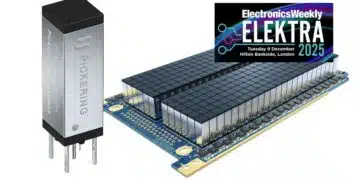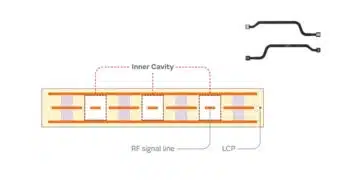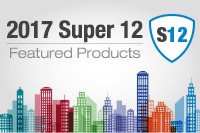source: Vishay news
MALVERN, Pa. — May. 2, 2017 — Vishay Intertechnology, Inc. (NYSE: VSH) today announced its “Super 12” featured products for 2017. Each year, Vishay identifies a dozen key semiconductor and passive components featuring new and improved technologies that can significantly improve the performance of end products and systems. Vishay’s Super 12 collection showcases the company’s industry-leading capabilities in semiconductor and passive devices and provides a cross section of Vishay’s very broad product portfolio.
The Super 12 products for 2017 are:
Vishay Siliconix SQJQ480E 80 V N-Channel TrenchFET® Power MOSFET — Offered in the compact PowerPAK® 8x8L package with a 1.9 mm profile, the Automotive Grade MOSFET offers low on-resistance down to 3 mΩ to minimize conduction and power losses for higher efficiency, while providing high temperature operation to +175 °C.
Vishay T59 Series of vPolyTan™ Multi-Anode Polymer Surface-Mount Chip Capacitors — Combining polymer tantalum technology with Vishay’s patented multi-array packaging (MAP), the T59 series delivers the industry’s highest capacitance density while maintaining best-in-class ESR down to 25 mΩ. Available in the molded EE (7343-43) case code, the capacitors offer up to 25 % better volumetric efficiency than similar devices.
Vishay Semiconductors VCNL4035X01 Proximity and Ambient Light Sensor — For gesture recognition in portable electronics and smart home, industrial, and automotive applications, the fully integrated VCNL4035X01 combines photo detectors for proximity and ambient light, a signal conditioning IC, a 16-bit ADC, and a driver for up to three external IREDs in one compact surface-mount package.
Vishay Dale WSLF2512 SMD Power Metal Strip® Current Sense Resistor — Combining a high power rating up to 6 W, element TCR down to ± 20 ppm/°, and extremely low resistance values down to 0.0003 Ω in the 2512 case size, the WSLF2512 provides a power density of 192 W/in^2 (0.3 W/mm^2) to save board space in high power circuits.
Vishay Semiconductors VTVSxxASMF Series of SMD TVS Protection Diodes — The industry’s first TVS to feature a 2 % breakdown voltage tolerance, VTVSxxASMF series devices are offered in the low profile SMF package and provide high surge capability of 400 W at 10/1000 µs for portable electronics.
Vishay Dale IHLE-5A Series of Low Profile, High Current Inductors — Available in 2525, 3232, and 4040 case sizes, Automotive Grade IHLE-5A series devices feature integrated e-shields for reduction of EMI — lowering costs and saving board space by eliminating the need for separate board-level Faraday shielding.
Vishay Siliconix SiC462 Synchronous microBUCK® Regulator — Featuring integrated high and low side MOSFETs and capable of supplying 6 A of continuous current at a switching frequency up to 1 MHz, the SiC462 delivers adjustable output voltage down to 0.8 V from a 4.5 V to 60 V input rail.
Vishay MKP1847H AC Filtering Film Capacitor—The MKP1847H is designed to ensure extremely stable capacitance and ESR parameters, regardless of operating conditions. Ideal for high humidity environments, it is the industry’s first such device to comply with the demanding damp heat test (85 °C, 85 % RM) for 1,000 hours at rated voltage.
Vishay Semiconductors 10 A to 30 A FRED Pt® Ultrafast Rectifiers — Vishay’s Ultrafast rectifiers in the SMPD package feature a low profile of 1.7 mm and are footprint-compatible with the TO-263. For automotive and industrial applications, the AEC-Q101 qualified devices offer high operating temperature to +175 °C and fast recovery time down to 25 ns.
Vishay Dale IHXL-2000VZ-5A Inductor — The IHXL-2000VZ-5A is the industry’s first AEC-Q200 qualified inductor to offer a rating of 190 A for a 20 % saturation current. With dimensions of 50.8 mm by 50.8 mm by 21.5 mm, the device’s 2000 case size is the largest available for a composite inductor.
Vishay Siliconix SiRA20DP 25 V N-Channel TrenchFET Power MOSFET — The SiRA20DP provides industry-low on-resistance down to 0.58 mΩ at 10 V to reduce conduction power loss and increase power density, while its low typical gate charge of 61 nC enables high efficiency for DC/DC conversion.
Vishay DCRF Water-Cooled Power Wirewound Resistor — With very high power dissipation to 9000 W, the DCRF handles almost 10x the power of naturally cooled resistors in the same size. Featuring a compact modular design, the device offers a high overload capacity of 2x nominal power for 60 s.
































